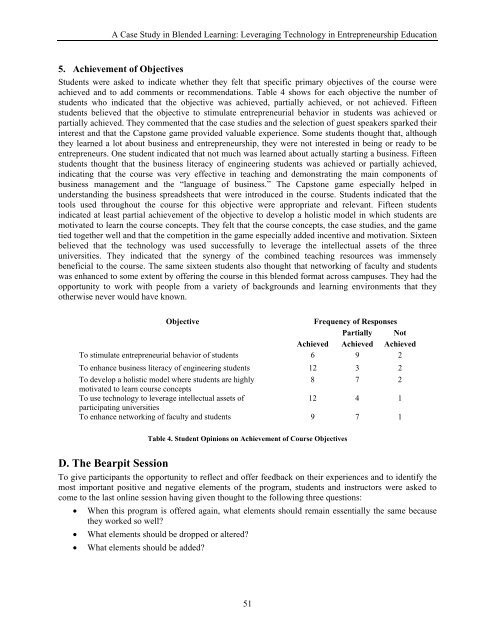Elements of Quality Online Education cation
Elements of Quality Online Education cation
Elements of Quality Online Education cation
You also want an ePaper? Increase the reach of your titles
YUMPU automatically turns print PDFs into web optimized ePapers that Google loves.
A Case Study in Blended Learning: Leveraging Technology in Entrepreneurship <strong>Edu<strong>cation</strong></strong>5. Achievement <strong>of</strong> ObjectivesStudents were asked to indicate whether they felt that specific primary objectives <strong>of</strong> the course wereachieved and to add comments or recommendations. Table 4 shows for each objective the number <strong>of</strong>students who indicated that the objective was achieved, partially achieved, or not achieved. Fifteenstudents believed that the objective to stimulate entrepreneurial behavior in students was achieved orpartially achieved. They commented that the case studies and the selection <strong>of</strong> guest speakers sparked theirinterest and that the Capstone game provided valuable experience. Some students thought that, althoughthey learned a lot about business and entrepreneurship, they were not interested in being or ready to beentrepreneurs. One student indicated that not much was learned about actually starting a business. Fifteenstudents thought that the business literacy <strong>of</strong> engineering students was achieved or partially achieved,indicating that the course was very effective in teaching and demonstrating the main components <strong>of</strong>business management and the “language <strong>of</strong> business.” The Capstone game especially helped inunderstanding the business spreadsheets that were introduced in the course. Students indicated that thetools used throughout the course for this objective were appropriate and relevant. Fifteen studentsindicated at least partial achievement <strong>of</strong> the objective to develop a holistic model in which students aremotivated to learn the course concepts. They felt that the course concepts, the case studies, and the gametied together well and that the competition in the game especially added incentive and motivation. Sixteenbelieved that the technology was used successfully to leverage the intellectual assets <strong>of</strong> the threeuniversities. They indicated that the synergy <strong>of</strong> the combined teaching resources was immenselybeneficial to the course. The same sixteen students also thought that networking <strong>of</strong> faculty and studentswas enhanced to some extent by <strong>of</strong>fering the course in this blended format across campuses. They had theopportunity to work with people from a variety <strong>of</strong> backgrounds and learning environments that theyotherwise never would have known.ObjectiveFrequency <strong>of</strong> ResponsesPartially NotAchieved Achieved AchievedTo stimulate entrepreneurial behavior <strong>of</strong> students 6 9 2To enhance business literacy <strong>of</strong> engineering students 12 3 2To develop a holistic model where students are highly8 7 2motivated to learn course conceptsTo use technology to leverage intellectual assets <strong>of</strong>12 4 1participating universitiesTo enhance networking <strong>of</strong> faculty and students 9 7 1Table 4. Student Opinions on Achievement <strong>of</strong> Course ObjectivesD. The Bearpit SessionTo give participants the opportunity to reflect and <strong>of</strong>fer feedback on their experiences and to identify themost important positive and negative elements <strong>of</strong> the program, students and instructors were asked tocome to the last online session having given thought to the following three questions:• When this program is <strong>of</strong>fered again, what elements should remain essentially the same becausethey worked so well?• What elements should be dropped or altered?• What elements should be added?51
















